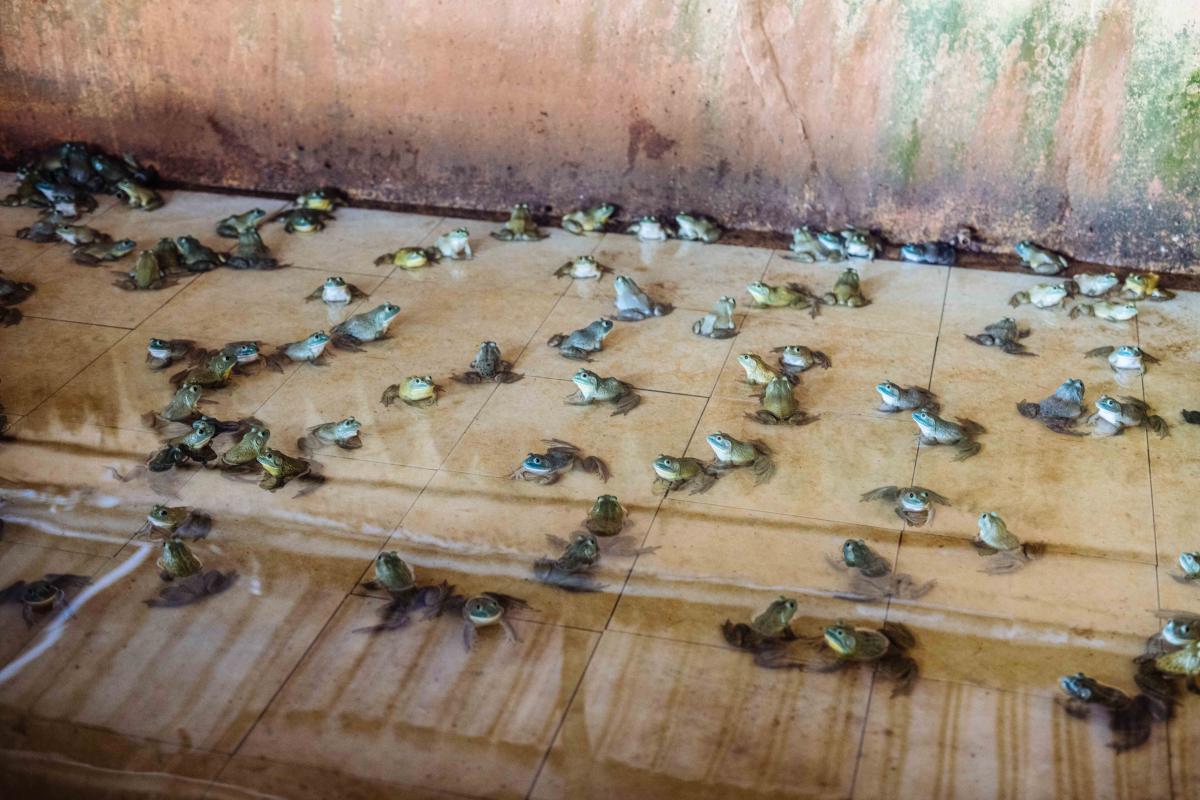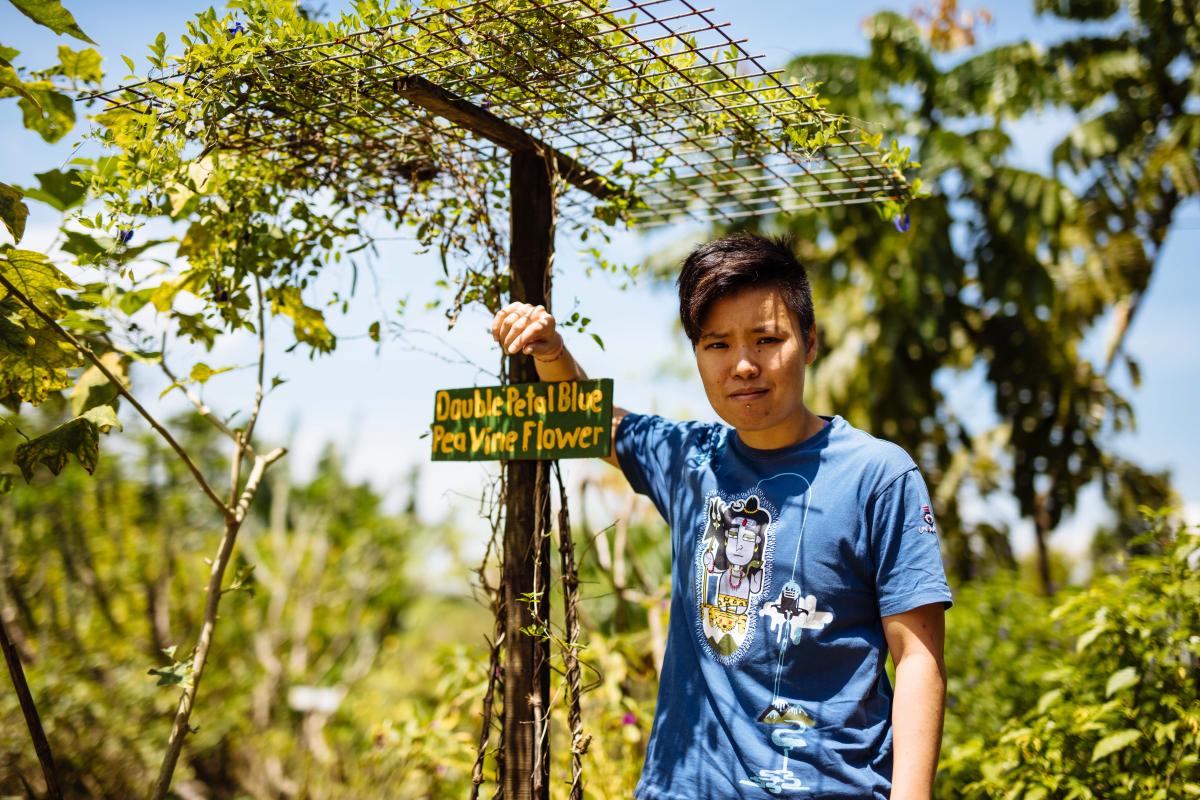Urban Farming
Urban growth is increasing the world’s population even as it consumes areas once used to produce food. With more mouths to feed and less space to do it with, we may need to rethink our concept of ‘arable land’.
Cover Photo: Jack Ng, founder and inventor of Sky Greens, at his high-tech urban vertical farm, which produces one ton of leafy greens every other day. Using a water-pulley system, growing troughs rotate to ensure even distribution of natural sunlight for each plant. The same water used to turn the troughs also nourishes the plants, obviating the need for a sprinkler system while reducing the consumption of water and electricity. (Photo: Pete Guest)
Jack Ng has a small strawberry plant on his windowsill. Even shaded from the Singapore sun and cooled by air conditioning, it doesn’t look in good shape. One day soon, though, Ng hopes that he will be able to grow commercial-scale crops of the fruit among the skyscrapers of this tropical city where the air is thick with humidity all year round and the daytime temperatures rarely drop below the high twenties.
Ng’s company, Sky Greens, is a pioneer of high-tech vertical agriculture. From the outside, its prototypes on a plot in Singapore’s Kranji district look like standard aluminium-framed greenhouses. Inside they hold long revolving platforms like oddly extruded Ferris wheels laden with green shoots. The plants are fed, watered and moved through the sunlight depending on their exact needs, arriving at the bottom of their circuit in time to be harvested. This computer-driven, high-volume farming can produce ten times the amount of vegetables as a traditional farm occupying the same land, using only a fraction of the water.
Kranji lies far past the northern boundaries of the city, where the high-rises give way first to industrial parks, then to a few scattered warehouses, and finally to dense greenery marked with signs warning that the army’s live fire zones lie inside. Throughout the day, fighter jets shriek low and loud overhead. Rural idyll it is not, but it remains the last sliver of farmland in one of the world’s most densely populated countries.

Farms are rare in Singapore, which imports more than 90% of its food. Jurong Frog Farm in the Kranji countryside was founded by Wan Bock Thiaw in 1981 as Singapore’s first and only of its kind, and it uses antibiotic- and hormone-free farming methods to produce frogs with meaty hind legs, a Singaporean delicacy. (Photo: Pete Guest)
The older generation still talk wistfully of the chickens-in-the-yard ‘kampong days’, but their children—baby boomers in the Western parlance—built a shining city of high-rise housing, sweeping expressways and malls stuffed with global brands. They drained swamps to put down foundations and fenced off the remaining tracts of rainforest for reservoirs, in one of the most ambitious urban development projects of the 20th century.
You seem to enjoy a good story
Sign up to our infrequent mailing to get more stories directly to your mailbox.Today, this is a city-state that is widely heralded as an exemplar of urban governance and economic planning, but Singapore is also an archetype of urban fragility. With no hinterland, the country relies almost entirely on imported food and water to survive. As much as 90% of Singapore’s food comes in from overseas, as does 60% of its water. In the case of the former, that means vast volumes of packaging and preservatives and huge energy expenditures to keep things fresh and edible in the tropical climate. The city-state’s future rests on the belief that the world will remain open to free trade, and that an abundance of food in its bigger neighbours will ensure a plentiful supply.
With an anti-globalisation movement in full swing, and climate change already disrupting food production across Southeast Asia, neither of those assumptions looks as ironclad as they did a few decades ago, which is pushing the country to reassess the decisions that have allowed its agriculture sector to wither, and to invest in high-tech farming methods like Sky Greens’.

Manda Foo, executive secretary of the Kranji Countryside Association, which represents around 40 farms in Singapore. She is a fierce advocate for Singapore’s tiny agricultural sector, looking for ways to boost food supply self sufficiency in the land-scarce city-state. (Photo: Pete Guest)
‘I think the realisation that food is going to be an issue for the world has hit home,’ says Manda Foo, executive secretary of the Kranji Countryside Association, which represents farmers in the area. ‘We might be in a position to buy food from other people because we have a lot of money, but we cannot assume that we will matter when there’s not enough food.’
Singapore, with 5.5 million people crammed into an island of a little over 700 km² (270 mi²), seems like an extreme example. However, the rate at which humanity is becoming an urban animal is such that many of the world’s cities are on a path to outstripping the capacity of the farmlands that feed them.
The world’s urban population has been increasing steadily for the last half-century. In 1960, 34% of the global population of 3 billion lived in cities, according to the United Nations. By 2014, it was 54% of 7 billion people. By 2050, according to current forecasts, it will be 66% of nearly 10 billion individuals, or another 2.8 billion urban inhabitants that need to be supplied by a rural population that will have changed only marginally in size.
Cold chains and supply chains into cities are already overstretched. Even in the developed world there are many ‘nutrition deserts’, areas empty of affordable fresh food and dependent on packaged, preserved products. Judging by current trends, that is only likely to get worse, unless cities can be redesigned to become not just consumers of food and fuel, but producers, integrating new agricultural technologies into their planning and construction.
That is already happening in many cities, albeit in an unstructured way. In South London, Growing Underground has turned deep tunnels into a farm for specialist salads; in Bangkok, EnerGaia is using carbon dioxide exhausts from urban industry to grow spirulina, an edible seaweed. In Singapore, several rooftop allotments provide fresh herbs and salad leaves to local restaurants. For the most part, however, they are small scale, feeding into a niche market that wants local produce for reasons of ethics or fashion.
Sven Yeo, co-founder of Singaporean vertical farming technology company Archisen, thinks that might change. The nascent ag-tech industry is heading to an inflexion point within the next decade, where falling costs of technology and proven business models intersect with rising concerns about food security and the impacts of climate change, he says.
In a world where cities are growing, farmlands are shrinking and populations are increasingly subject to unpredictable geopolitical and climatic shifts, Singapore may provide a glimpse into the future of food production and distribution.
Archisen wants to use cloud computing and Internet of Things technology to develop urban farming methods that maximise food production and minimise use of space and water. These technologies could be applied to manage an intricate web of small-scale production and distribution, abrogating the need for any kind of central aggregation or middlemen, or they could be used for huge ‘skyscraper farms’, he says.
The company is in the process of raising funds for an industrial-scale project in Jurong in the southwest of Singapore with a partner that has expertise in ‘last mile’ logistics, which they hope can solve the distribution challenges that small farms face. The project has started to pick up interest from private investors and venture capital funds.
‘Right now, I think everyone in the industry is trying to drive this past a certain point where one of us has demonstrated that we are able to construct a farm that is very productive, and we are able to offload our produce in an effective man-
ner, maintaining a profitable venture. I think that will unlock the whole industry,’ Yeo says.
At Sky Greens, Ng also believes that urban farming can be distributed or centralised, or a combination of the two, but his industrial-level visions are the most dramatic.
Although Singapore has little space to spare at ground level, it has always built upwards. The flanks of its skyscrapers and housing blocks represent huge tracts of unused vertical real estate, he says, that could become fertile ground.
‘We don’t have much land, but we have plenty of vertical area,’ he says. ‘Urban agriculture can be part of the design of the city. It can be part of the architecture of buildings… Every housing tower could rent out its [walls] to become a farm.’
He has worked with urban developers in China to integrate factory farms into the planning of new cities, with mixed success. Retrofitting existing cities is a bigger challenge. His technology can be scaled up to create huge, moving green conveyor belts that roll up the sides of tall buildings. As Ng says, the self-described ‘garden city’ is already draped with greenery, but it is all for show; nothing is edible. Developers have not exactly welcomed his proposals. Their main objection has been aesthetic: no one wants to have their green wall harvested and bare.
Other projects, such as putting farms on car parks and public housing estates, have foundered because of mundane challenges. Start-ups struggle to get bank loans; others find that their permits get stuck in limbo between different government agencies.
Quite often, bureaucratic inertia is what derails moves towards utopian visions of cities that are sustainable in food, water and energy, according to Alan Marshall, an environmental scientist at Bangkok’s Mahidol University and the convener of Ecotopia 2121, a project that tries to extrapolate what global cities will look like in a century’s time.
As a student, Marshall researched how to build ‘ecological closed loops’ for use in space, technology that would allow astronauts to recycle water and organic matter to grow their own food. That kind of space-age agriculture is still the foundation of many fictional visions of urban self-reliance, composed of sealed towers of stacked vertical farms, typically drawn as sweeping futurist buttresses.
That kind of city, where the whole system is integrated for total self-reliance, is probably a mirage. ‘For philosophical and scientific reasons, I just don’t think you can do it,’ Marshall says, although he adds that ‘you might as well try’.
A more likely scenario is a number of distributed projects producing a small proportion, maybe 20 or 25%, of a city’s food, integrated into the overall food supply in the same way that small-scale solar can be built to feed into national grids.
The technology to do so exists now; what is missing, according to Marshall, is political will. ‘Real change is not going to come until we have democratic institutions that show that people care about these things,’ he says. ‘Twenty years ago, we didn’t care about dirty air so much. Now, in the centre of Beijing, people don’t care about access to water… In the future I’m sure, as these important resources get taken away, they will want to voice these concerns.’

